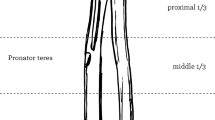Abstract
Compared to adulthood, the skeletal structure in the paediatric age has anatomical, biomechanical and physiological differences that, in case of trauma, cause different types of lesions with different indications and treatment modalities. The basics of paediatric traumatology treatment are generally the same both in individual lesions and in multiple fractures. However, in the latter, the influence must always be considered of lesions affecting other systems in patient management and prognosis. It is always important to consider that the stabilization of fractures, particularly of long bones, improves nursing assistance, reduces pain and blood loss, and make easier the execution of technical required examinations. Overall, it is appropriate to confirm that in case of multiple fractures, surgical stabilization may have indication in a larger number of cases compared to children with isolated fractures.


Similar content being viewed by others
Bibliografia
Degenhardt P, Kleber C, Bail HS (2009) Emergencies in pediatric traumatology-fractures in the growing age and pediatric polytrauma. Anasthesial Intensivmed Notfalled Schmerzther 44(6):445–449
Schalamon J, Von Bismarck S, Schober PH, Hollwarth ME (2003) Multiple trauma in pediatric patients. Pediatric Surg Int 19(6):417–423
Pandya NK, Upasani VV, Kulkarni VA (2011) The pediatric polytrauma patient: current concepts. J Am Acad Orthop Surg 21(3):170–179
Strohm PC, Schmittenbecher PP (2011) Fracture stabilization in polytraumatized children. Unfallchirurg 114(4):323–332
Vallier HA, Wang X, Moore TA et al. (2013) Timing of orthopaedic surgery in multiple trauma patients: development of a protocol for early appropriate care. J Orthop Trauma 27(10):543–551
Vallier HA, Super DM, Moore TA, Wilber JH (2013) Do patients with multiple system injury benefit from early fixation of unstable axial fractures? The effects of timing of surgery on initial hospital course. J Orthop Trauma 27(7):405–412
Abzug JM, Herman MJ (2012) Management of supracondylar humerus fractures in children: current concepts. J Am Acad Orthop Surg 20(2):69–77
Lagrange J, Rigault P (1962) Les fractures de l’extrémité inferieure de l’humérus de l’enfant. Rev Chir Orthop 48:330–336
Loder RT, Gullahorn LJ, Yian EH et al. (2001) Factors predictive of immobilization complications in pediatric polytrauma. J Orthop Trauma 15(5):338–341
Greco F, De Palma L (1977) Healing of fractures in severe cranial trauma. Arch Putti Chir Org Mov 28:105–111
Silber EJ (2001) Analysis of the cause, classification, and associated injuries of 166 consecutive paediatric pelvic fractures. J Pediatr Orthop 21:446–450
Grisoni N, Connor S, Marsh E et al. (2002) Pelvic fractures in a pediatric level I trauma center. J Orthop Trauma 16(7):458–463
Blasier RD, McAtee J, White R, Mitchell DT (2000) Disruption of the pelvic ring in pediatric patients. Clin Orthop Relat Res 376:87–95
Banerjee S, Barry MJ, Paterson JM (2009) Paediatric pelvic fractures: 10 years experience in a Trauma Centre. Injury 40(4):410–413
Loder RT, O’Donnell PW, Feinberg JR (2006) Epidemiology and mechanisms of femur fractures in children. J Pediatr Orthop 26:561–566
Von Heideken J, Svensson T, Blomqvist P et al. (2011) Incidence and trends in femur shaft fractures in Swedish children between 1987–2005. J Pediatr Orthop 31:512–519
Hedin H, Borgquist L, Larsson S (2004) A cost analysis of three methods of treating femoral shaft fractures in children. Acta Orthop 75(3):241–248
Poolman RW, Kocher MS, Bhandari M (2006) Pediatric femoral fractures: a systematic review of 2422 cases. J Orthop Trauma 9:648–654
Allison P, Dahan-Oliel N, Jando VT, Yang S (2007) Treatment of open femur fractures in children: comparison between external fixator and intramedullary nailing. J Pediatr Orthop 27(7):748–750
Ramseier LE, Bhaskar AR, Cole WG, Howard AW (2007) Treatment of open femur fractures in children. Comparison between external fixator and intramedullary nailing. J Pediatr Orthop 27:748–750
Anglen JO, Choi L (2005) Treatment options in pediatric femoral shaft fractures. J Orthop Trauma 19:724–733
Kocher MS, Sink EL, Blasier RD et al. (2009) Treatment of pediatric diaphyseal femur fractures. J Am Acad Orthop Surg 17:718–725
Ramseier LE, Bashkar AR, Cole WG, Howard AW (2011) Open fractures of the femur in children: analysis of various treatment methods. J Child Orthop 5(2):101–108
Gordon JE, O’Donnell JC (2012) Tibia fractures: what should be fixed? J Pediatr Orthop 32(1):S52–S61
Setter KJ, Palomino KE (2006) Pediatric tibia fractures: current concepts. Curr Opin Pediatr 18:30–35
Pandya N, Edmonds E, Mubarak SJ (2011) The incidence of compartment syndrome after flexible nailing of pediatric tibial shaft fractures. J Child Orthop 5:439–447
Valenziano CP, Chattar-Cora D, O’Neill A et al. (2002) Efficacy of primary wound cultures in long bone open extremity fractures: are they of any value? Arch Orthop Trauma Surg 122(5):259–261
Stewart DA, Coombs CJ, Graham HK (2012) Application of lower extremity injury severity scores in children. J Child Orthop 6(5):427–431
Conflitto di interesse
Nessuno.
Author information
Authors and Affiliations
Corresponding author
Rights and permissions
About this article
Cite this article
Di Lazzaro, A., Giusti, C., Tucci, G. et al. Trattamento ottimale del paziente pediatrico polifratturato: arti superiori, bacino e arti inferiori. LO SCALPELLO 28, 116–122 (2014). https://doi.org/10.1007/s11639-014-0078-4
Published:
Issue Date:
DOI: https://doi.org/10.1007/s11639-014-0078-4



